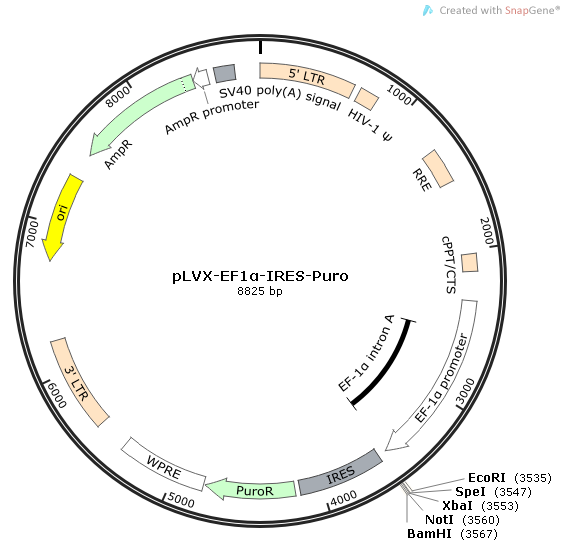pLVX-EF1α-IRES-Puro 载体
| 质粒类型: | 慢病毒载体 |
|---|---|
| 高拷贝/低拷贝: | 高拷贝 |
| 启动子: | EF1α/ EF1a |
| 克隆方法: | 多克隆位点,限制性内切酶 |
| 载体大小: | 8825 bp (查看载体序列) |
| 5' 测序引物及序列: | EF-1a Forward: TCAAGCCTCAGACAGTGGTTC |
| 3' 测序引物及序列: | IRES-R: CCTCACATTGCCAAAAGACG |
| 载体抗性: | Ampicillin (氨苄青霉素) |
| 筛选标记: | 嘌呤霉素(Puromycin) |
| 备注: | 含有IRES序列和EF1a启动子,慢病毒表达载体 |
pLVX-EF1α-IRES-Puro is an HIV-1-based, lentiviral expression vector designed to simultaneously and constitutively express a protein of interest and puromycin resistance (Puror) from a bicistronic transcript in mammalian cells. Expression of your protein of interest and Puror from a bicistronic transcript allows puromycin resistance to be used as an indicator of transduction efficiency and a marker for selection.
Simultaneous expression of a protein of interest and puromycin resistance is made possible by the presence of an encephalomyocarditis virus internal ribosome entry site (IRES; 1) positioned between the multiple cloning site (MCS) and Puror. The IRES allows a protein of interest and puromycin resistance to be translated from a single bicistronic mRNA. Stable, constitutive expression of the bicistronic transcript is driven by the EF1α promoter (PEF1α), which continues to be constitutively active even after vector integration into the host cell genome (2).
pLVX-EF1α-IRES-Puro contains all of the viral processing elements necessary for the production of replicationincompetent lentivirus, as well as elements to improve viral titer, transgene expression, and overall vector function. The woodchuck hepatitis virus posttranscriptional regulatory element (WPRE) promotes RNA processing events and enhances nuclear export of viral RNA (3), leading to increased viral titers from packaging cells. In addition, the vector includes a Rev-response element (RRE), which further increases viral titers by enhancing the transport of unspliced viral RNA out of the nucleus (4). Finally, pLVX-EF1α-IRES-Puro also contains a central polypurine tract/central termination sequence element (cPPT/CTS). During target cell infection, this element creates a central DNA flap that increases nuclear import of the viral genome, resulting in improved vector integration and more efficient transduction (5). The vector also contains a pUC origin of replication and an E. coli ampicillin resistance gene (Ampr) for propagation and selection in bacteria.


